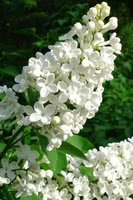Mon-Fri 9am - 5pm Mountain time
Western Snowberry vs Madame Lemoine White Lilac
Symphoricarpos occidentalis
Syringa vulgaris Madame Lemoine
NOT AVAILABLE THIS SEASON - MIGHT RETURN
NOT AVAILABLE THIS SEASON - MIGHT RETURN
Like the Common Snowberry, the Western Snowberry is a small shrub with pink flowers useful for feeding livestock and preventing erosion. Unlike the common species, however, the Western Snowberry is much more suited to wet conditions, capable of persevering through poor soil drainage and occasional flooding.
After the Snowberry's flowers have bloomed, it produces berries which often last on the plant through winter. These berries are toxic to humans, but livestock and local wildlife love them! Those hoping to attract wildlife to their property can plant Snowberry and expect to see animals foraging on it much later in the year than other plants.
Madame Lemoine White Lilac is great for attracting butterflies and hummingbirds. Winner of the Garden Merit from the Royal Horticultural Society, the Madame Lemoine White Lilac has fragrant white flowers that are great for cutting and blue-green foliage that turns yellow in the fall. This attractive shrub is also deer resistant.
Western Snowberry Quick Facts
Madame Lemoine White Lilac Quick Facts
Toxicity: berries are toxic to humans

